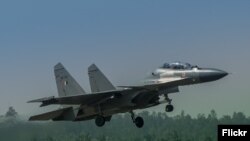The Indian Air Force has inducted three female fighter pilots marking the first time one of the world's largest militaries has opened the door to women in combat roles.
Mohana Singh, Bhawana Kanth and Avani Chaturvedi were commissioned in the fighter stream of the air force on Saturday at a parade in Hyderabad.
It’s a huge step forward for the 1.2 million Indian armed forces that have trailed countries like the United States, Britain, Israel and neighboring Pakistan in allowing women into the cockpit of fighter jets.
The Indian air force could blaze the trail for the army and navy. In February, Indian President Pranab Mukherjee announced in parliament that women will be allowed in all fighter streams of the armed forces.
Asked about the challenges she is likely to encounter as a woman fighter pilot, Mohana Singh shrugged, “Nothing different from my male counterparts, as much as they face.”
Women pilots make up about 100 of the 1,500 air force pilots, but have so far served only in helicopter and transport units.
The three women fighter pilots will be trained for a year on Hawk advanced trainer jets before they get to fly supersonic warplanes by next year.
The Indian air force has called their induction a “progressive step in keeping with the aspirations of Indian women and in line with contemporary trends in armed forces of developed nations.”
But it also says the induction has been made on an “experimental basis,” which it will study for five years. Observers take that as an indication that although a step forward has been taken, gender parity will only creep in slowly in the armed forces.
For the Indian forces, women’s vulnerability if captured and the challenge of frontline deployments have been major sticking points.
Former air vice marshal Manmohan Bahadur with the Center for Air Power Studies in New Delhi told VOA the armed forced are taking a cautious approach.
“So the point is: Is putting women in combat in harm’s way that has to be accepted by society," he said. "For India it has happened now, in other countries it has happened earlier.”
Part of the nudge to change attitudes towards women came from courts, which have ruled in favor of better working conditions for female officers and called on the armed forces not to block their progress. Until 2010, they were only offered temporary commissions of up to five to 10 years. Women constitute a mere 2.5 percent of armed personnel, most of them administrators, intelligence officers, doctors and nurses.
Bahadur says the change in attitude to women in combat will happen slowly.
“It is a natural tendency to shield the women," he said. "That may happen in the initial stages, but after some time, it will become a day in and day out affair and then it does not matter. So, it is a gradual process that should be allowed to take place.”
The induction of the three women received huge coverage in the Indian media with newspaper headlines like “Women Fighter Pilots Break Cloud Ceiling,” and “No Sky Too High.”
Meanwhile, the female fighter pilots are excited about their pioneering role.
“The only thing I would like to say is dream big and work for it," said newly commissioned fighter pilot Avani Chaturvedi. "If you really wish to do something, all the ways will automatically open for you.”











